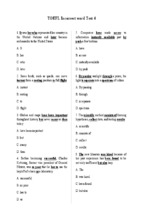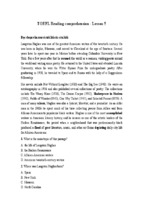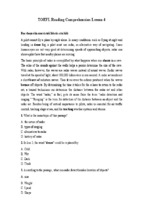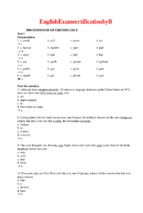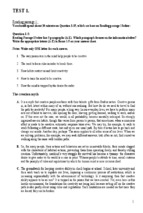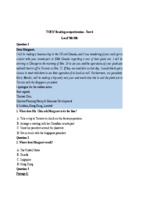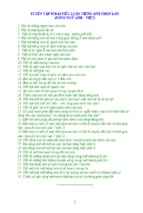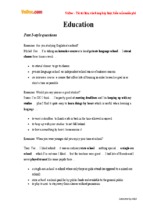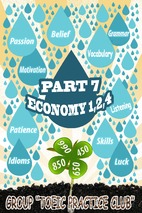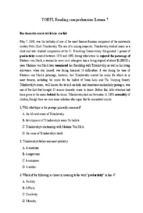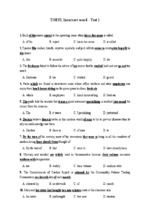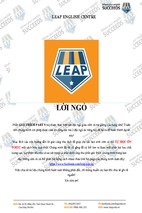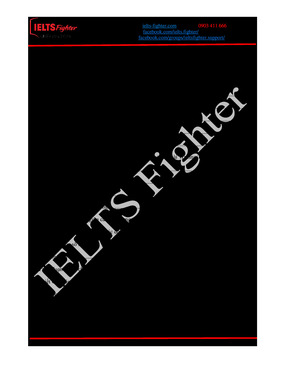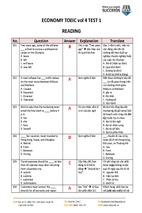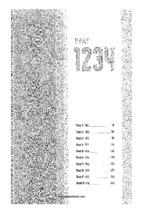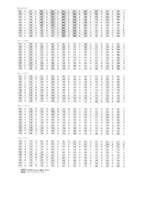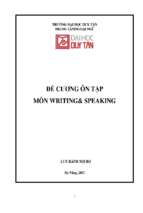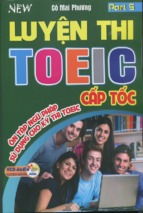Focus on
Headinq
and
lUritinq
High Intermediate
Andrew K. ~nqlish
Laura Hanahan ~nqlish
SIHIES EDITORS
frances Boyd
Carol Humrich
~LONGMAN
NorthStar: Focus on Readin g and Wriling, High Inrerrnedia rc
© 199 8 by Addison Wesley Longman, Inc.
All rights reserved .
N o part of this pu blicatio n may be reproduced,
stored in a retrieval system , or transmitted
in any form or by any means, electronic, mechan ical,
photocopying, recording, or otherwise,
without th e prior permission of the publisher.
Addison Wesley Longman, 10 Ban k Street, White Plains, l'\Y 10606
Edito rial directo r: Allen Ascher
Senior acq uisitio ns editor: Louisa Hcllcgcrs
Directo r of design and productio n: Rhea Banker
Development editor: Penny Laporte
Production man ager: Ma rie Mctcamara
Managing editor: Linda Mose r
Senior production editor: Lynn Conrrucci
M an ufactu ring supervisor: Edith Pullman
Pho to resea rch: Diana Non
Cover design: Rhea Banker
Cover illustration: Robert Delaunay's Circular Forms, Sun No. 2,
1912 -1913. Gira udoniArt Resource, NY. L&M Services B.V.
Amsterdam 970902
Text design and composition: Delgado Design, Inc.
Text credits : See page xiii
Phot o and art credits: See page xiv
Library of Congress Cataloging-in-Publication Data
English, Andrew K.
Norch'ear : Focus on reading and writing , high
intermediate/Andrew K. English, Lau ra Monahon English
p.
em. - (NorthStar!
ISBN 0-20 1-84669- 1 (pbk.)
L English language-Text boo ks for foreign spea kers. 2. Reading
comprehension-Problems, exercises, ere. 3. Report wr itingPro blems, exercises, etc. I. English, Andrew II. "ide III. Series.
I'E112 8.E58 1998
428. 6'4----dc21
1 23 4 5 6 7 8 9 l Q-Rlli-03 02 01 0099 98
97-4326 1
CIP
Fo r our parents who ra ised us with boo ks an d for ou r litrle
masterpiece of calipedia, Sam.
Introd uction
1
U NTRUTH A ND CO N SE Q UE N C ES
Theme: Media
Reading O ne: Peeping Tom Journalism, Nancy Day
Reading Two : Focus on Bomb Suspect Brings Tears
and a Plea, Rick Bragg
Grammar:
Passive Voice
Style,
Topic Sentences
CRIME AND PUN IS H ME NT
Theme: J ustice
Reading One: Crimebusting: \Vhat Works? Methods of
Punishing. John Di Consiglio,
James Anderson, and Pat ricia Smith
Reading Two: Michael Fay's Caning, Sarah Fenske
and Tram Kim Ngu yen
Grammar:
Gerunds and Infinitives
Style:
The Three-Parr Paragra ph
DYING FOR THEIR BELIEF S
Theme: Medicine
Reading O ne: Dying for Their Beliefs: Christian
Scientist Parents on Trial in Girl's Death,
Jeffrey Good
Reading Two: No rman Cousins's Laugh Therapy
Grammar:
Past Unreal Cond itiona ls
Style:
Opi nion Essays
6
11
17
21
27
32
38
43
47
55
59
63
68
71
v
•
CON TE N TS
THE CALM A FTER TH E STORM
T heme: Na tu ral Disasters
Readin g O ne: M y First Night A /on e in th e Caribbean,
Ga briel Garcia Ma rquez
Reading Two: The Story of an Eyewitness, Jack London
Grammar:
Identifying Adjective Clauses
Style:
Descriptive Writing
FROM TRASH TO TREASURE
Theme: Conservation
Reading O ne: St. Paul Couple Give Com pos ting a Worm
Welcome, Chuck Haga
Reading Two: Eartb ship Hom es Catch O ld Ti res
on Rebound, Eva f erguson
Grammar:
Advisab ility and Obligation in the Past
Style:
Cause and Effect
GIVE AND LEARN
Theme: Philant hrop y
Readin g One: j ustin Lebo, Phillip Hoose
Readin g Two: Ma ndato ry Volunteering
Gra mmar:
Tag Q uestions
Style:
Punctuat ion
HOMING IN ON EDUCATION
T heme: Education
Reading One : Teaching at Hom e Hits Ne w High
with Internet, Dor othy l .epko wska
Reading Two: The Flat They Had, Isaac Asimov
Grammar:
Direct an d Indirect Speech
Style:
Concess ions
77
80
84
89
93
97
101
106
112
115
123
127
134
14 2
145
15 1
155
159
167
172
CONT ENTS . .
I
I
WE'VE COME A lONG W A Y
Theme: Space
Reading One: First in Space, Alan Shepard
and Dcke Slayton
Reading Two: Pink Socks and [ello, Shannon Lucid
Phrasal Verbs
Gra mmar:
Style:
Chronological Order-Expre ssing lime
THE GRASS IS AL W A YS GR EEN E R
Th eme: Immigration
Reading One: Poor Visitor, Jam aica Kincaid
Reading Two: Nosta lgia. Virgilio Davila
Gra mmar:
Past Perfect
Style:
Comparisons and Contras ts
I
TAKE IT OR lE A VE IT
Theme: Technology
Reading One: Inside the House, Bill Gates
Reading Two: Th oreau's Home. Heney David Thoreau
Grammar:
Futur e Progressive
Style:
Outlining
Answer Key
179
184
190
198
201
207
211
217
222
226
231
237
242
247
252
259
N orthSta r is an innovative four-level, integrated
skills series for learners of English as a Second
or Fo reign Language. T he series is divided into
two strands: listening/speak ing and
read ing/writing. There arc four books in each
strand, ta king students fro m the Basic to the
Advanced level. Th e two books at eac h level
exp lore different aspects of the same contemporary themes, which allows for reinforcement of
both vocabulary and grammatical struc tures.
Each stran d and each book can also functi on
independentl y as a skills co urse built on highinterest thematic con tent.
N orthStar is designed to work alongside
Addis on Wesley Longman 's Focus on Grammar
series, and stu dents ar e referr ed directly to
Focus on Grammar for furthe r pra ctice and
derailed gra mma tical explanations.
N orthStar is wr itten for students wit h academic as well as perso nal language goal s, for
those who want to learn English while exploring enjoyable, intellectual ly challe nging themes.
NORTHS TAR'S PURPOSE
The NorthStar series grows out of our experience as teachers an d curriculum designers,
curre nt researc h in second -lang uage acquisition
an d peda gogy, as well as ou r beliefs abo ut
language teach ing. It is based on five principles.
Principle O ne: In lang uage learni ng, making
meaning is all-imp ortant. Th e more pro fou ndly
stu dents arc stimulated intellectually and
emotionally by wha t goes on in class , the more
language they will use an d retai n. One way
that classroom teachers ca n engage stu dents in
ma king mea ning is by organ izing lang uage
study thematically.
We ha ve tried to identify themes tha t arc upto -date, sop histicated, an d varied in tonesome lighter, some more serio us---on ideas and
issues of wide concern. T he forty themes in
NorthStar provide stimulating to pics for t he
readings and the listen ing selections, including
wh y people like dangerous sports, the effect of
food on mood , an O lympic swimmer's fight
against AIDS, experimental punishments for
juvenile offenders, people's relationships wit h
their cars, phi lant hropy, emotional intelligence,
privacy in th e workplace, and the influence o f
ar ts education on bra in develo pment.
Each corresponding unit of the integrated
skills books explores two distinct topics
related to a single theme as the chart belo w
illust rates.
T heme
Listening/S peak ing Topic
Reading/Writing Topic
Insects
Offbeat professor fails at
breeding pests, then reflec ts
on expefJence
Extract adapted
Kafka's "The
Shyness, a personal and
cultural view
Definition
of, criteria
for, success
Personality
M etamorphosis"
ix
•
I N TR OD U C TI O N
Principle Two: Second-language learn ers,
particularly adults, need and want to learn both
the form and content of the language. To
accomplish this, it is useful to integrate
language skills with the study of gra mma r,
voca bulary, an d American culture.
In N orthStar, we have integrated the skills in
two stran ds: listening/speaking and readi ng!
writing. Furth er, each thematic unit integrates
the study of a grammatical point with related
vocabulary an d cultural information. When
skills are integrated, languag e use inside of the
classroom more closely mimics lan guage use
outside of the classroo m. This mot ivates
students. At the same time, the focus can shift
back and forth from what is said to how it is
said to the relat ionship between the two .
Stu dents are apt to use mo re of the ir senses,
mo re of themselves. W hat goes on in the classroom can also ap peal to a greater variety of
learn ing styles. Gra dually, the integra ted-skills
approach narrows the gap between the ideas
and feelings students wa nt to express in speaking and writing and their present level of
English proficiency.
The link between the listening/speaking and
read ing/w riting strands is close enough to allow
students to explore the th emes and review
gram mar and reinforce vocabulary, yet it is
dist inct enough to susta in th eir inte rest. Also,
language levels and gra mma r point s in
N orthStar are keyed to Add ison Wesley
Long man's Focus on Grammar series.
Prin ciple T hree: Both teachers an d students
need to be active learn ers. Teachers mu st
enco urage students to go beyond whatever level
they have reached.
With this principle in mind, we have tr ied to
make the exercises creative, active, and varied.
Several activities call for considered opinion an d
critic al th inking. Also, the exercises offer
students man y opportu nities for individual
reflectio n, pair- and small-grou p learn ing, as
well as out-of-class assignment s for review and
research. An answer key is printe d on perfo-
rate d pages in the back o f each book so the
teacher or st udents can remove it. A teacher's
man ual, w hich accompanies each boo k, features
ideas and tips for tailoring the mat erial to individual gro ups o f students, planning the lessons,
managing t he class, and assessing st udents'
progress.
Principle Four: Feed back is essential for
language learn ers and teachers. If students are
to become better able to express themselves in
English, they need a response to both w hat they
are expressing and how they are ex pressing it.
N orthStar's exercises offer multiple opport unities for oral and writte n feedback from fellow
students and from the teacher. A number of
open-ended op inion and in ference exercises
invite students to share and discuss their
answers. In info rmation gap , fieldwork, an d
presentatio n activities, students mu st prese nt
and solicit informatio n and op inions fro m their
peers as well as members of their communities.
Throughout these activities, teachers may offer
feedback on the for m and content o f stude nts '
lang uage, sometimes on the spot and sometimes
via audio/video recordings or no tes.
Principle Five: The quality of relationship s
among the students and between the students
and teache r is impo rtant, particularly in a
language class where stude nts arc asked to
express themselves on issues and ideas.
The infor mation and act ivities in No rthStar
promote gen uine interaction, acceptance of
differences, and au thentic communication. By
buildin g skills and exp loring ideas, t he exercises
help students participat e in discussions and
write essays of an increasingly more complex
and sophisticated na ture.
DESIGN OF THE UNITS
For cla rity and ease of use, the listening/speaking and read ing/writing str ands follow the same
unit outline given below. Each unit contains
from 5 to 8 hours o f classroo m material.
Teachers can customize the units by assigning
I NTROD U CT IO N . .
some exercises for homework and/or skipping
others. Exercises in sect ions 1- 4 are essential
for comprehens ion of the to pic, while teache rs
may want to select among the act ivities in
sections 5- 7.
Activities ask students to explicitly relate the
two pieces, consider consequences, distinguish and express points of view. In the se
exercises, students can attain a deeper und ersta nding of the topic.
1. Approaching the Topi c
A warm-up , these activities intro duce
students to the general context for listening
or reading and get them personally
co nnected to the to pic. Typically, stude nts
might react to a visual image, describe a
personal experience, or give an opinion
orally or in writing.
5. Reviewing Language
These exercises help students explore, review,
and play with language from both of the
selections. Using the thematic con text,
st udents focus on language: pronu nciat ion,
wo rd forms, prefixes and suffixes, word
do mains, idiom atic exp ressions, analogies.
The listening/speaking str and stresses oral
exerc ises, while the reading/writing strand
focuses on wr itten respon ses.
2. Preparing to Listen/Preparing to Read
In this section, students are introduced to
information and language to help them
comprehend th e specific ta pe or text they
will stu dy. Th ey might rea d and react to
a paragrap h framing the topic, prioritize
facto rs, or take a general-knowledge quiz
and share inform ation . In the vocab ula ry
section, students wo rk with words and
exp ression s selected to help them with
co mprehension .
3. Listening OnelReadin g One
Th is sequence of four exercises guides
students to listen or read wit h understa nding
and enjoy ment by practicing the skills of
(a) predictio n, (b) comprehension of main
ideas, (c) co mprehension of deta ils, and
(d) inference. In activities of increasi ng deta il
and co mplexity, stude nts learn to grasp and
interpret meaning. The sequence culminates
in an inference exercise that gets stu dents to
listen and read between the lines.
4. Listening Two/ Reading Two
Here stude nts work wit h a tape or text that
builds on ideas from the first listening/reading. Th is second ta pe or text contrasts with
the first in viewpoint, genre , and/or tone.
6. Skills for Expression
Here students practice related gramma r
poin ts across the theme in both topi cs.
The gra mmar is practiced o rally in the listening/speaking stra nd , and in writing in the
reading/wr iting stran d. For addi tio nal pracrice, teachers can turn to Addison Wesley
Longman's Focus on Grammar, to wh ich
NorthStar is keyed by level and grammar
points. In the Style section, students pract ice
functions (listening/speaking) or rhetorical
styles (reading/writing) th at prepare them to
express ideas on a higher level. With in each
unit, students are led from controlled to freer
practice of productive skills.
7. O n Your O wn
Th ese activities ask students to apply the
content, language, grammar, and style they
have pra cticed in the unit. The exercises elicit
a higher level of speaking or writing than
st udents were capa ble o f at the start of the
unit. Speak ing topics include role plays,
surveys, presentations, and experiments .
Writing topics include paragr aphs, lette rs,
summaries, and academic essays.
•
I N T R O D U C TI O N
In Fieldwork, th e second part of On Your
Own, students go outside of th e classro om,
using their know ledge and skills to gather data
from person al interviews, librar y research ,
and telephone or Internet research. They report
and reflect on th e data in oral or written
presentati on s to th e class .
AN INVITATION
We think of a good rexrbook as a mu sical score
o r a movie script: It tells you the moves and
ro ughly how quick ly an d in wha t sequence to
make them. But until yo u an d you r stu dents
bring it to life, a hook is silent an d static, a
mere possibility. We ho pe tha t NorthStar
orients , guides, and inte rests yo u as teachers.
It is our hope th at the NorthStar series stim ulates yo ur srudcnrs' thinking, wh ich in (urn
stimulates th eir langu age learni ng, and th at
the > will have man y o pport un ities to reflect on
'
th e viewpo ints o f jou rnalists, commenta to rs,
researchers, ot her students , and people in th e
community. furth er, we hope th at No rthStar
gu ides th em to develop the ir own viewpo int on
th e many and varied th emes encompassed by
thi s series.
We welcome your comments and questions.
Please send them to us at the publisher:
f rances Boyd an d Caro l Numr ich, Edito rs
N orthStar
Add ison Wesley Longman
10 Bank Street
Wh ite Plains , N Y 10606-1 951
o r, by e-ma il at :
aw /eh @awl.com
ACKNOWLEDGMENTS
Writing a textb oo k, as with any writing
process, is a process filled with peak s, valleys,
and roads leading to territories unknown .
Fortunat ely \v had wonderful guides through·e
out this process whose expertise and creativity
are wov en into every page o f thi s boo k. To
th ese peopl e we owe great th ank s. First, to
Allen Ascher for bringing thi s project to us
and having confidence in us. Second, to Carol
N umrich, our sage, for her outstanding
patience, ex pertise, and most impo rtantly her
unending suppo rt and enthusiasm. Words truly
cannot express wh at a joy an d privilege it wa s
to work wit h her. Third, to ou r editor Pen ny
Laporte for her humor in th e late stages of editing (when humor is a requirement) and for her
dedicati on to her craft. We wou ld also like to
thank Diana Non for her ent husiastic support
an d help resear ch ing the artscript in th e
eleventh hour. Last, but by all means not least,
we owe a grea t deal of th an ks to o ur students
at Ro xbury Com munity College and Boston
University for th eir feedback , coopera tion, and
inspiration during th e pilot ing process.
AKE and
L~l E
Text Credits
For permission to use the selections reprinted in this book , the aut hors are grateful to
the following publishers and copyright holders:
Page 6, " Peeping Tom Journalism, Mfrom Sensational TV-Trash or Journalism ? by
Nancy Day. Reprinted by permission of Enslow Publishers. Page 11, "Focus on Bomb
Suspect Brings Tears and a Plea," by Rick Bragg from The New York Times, August 27,
1996. Reprinted by permission of The New York Times. Page 32, "C nm ebusting: What
Works? Methods of Punishing," from Scholastic Update, September 15, 1995 issue.
Copyright © 1995 by Scholastic Inc. Reprinted by permission of Scholastic Inc. Page 39,
"Michael Fay's Caning," originally titled "Ne xt Corres pondents on Fay," from The
Plain Dealer, page 2E, May 30, 1994. Reprinted with permission from The Plain Dealer
© 1994. All rights reserved. Page 59, "Dying for Their Beliefs," edited from the original
text written by Jeffrey Good from The St. Petersburg Times, April 9, 1989. Reprinted
with permission by The St. Petersburg Times. Page 80, "11y First Night Alone in the
Caribbean," from The Story of a Shipwrecked Sailor by Gabr iel Gard a Marquez,
transl ated by Randolph Hogan. Translation copyright © 1986 by Alfred A. Knopf, Inc.
Reprinted by permission of the publisher. Page 84, "The Story of an Eyewitness," by
Jack London from Colliers, May 5, 1906. Page 102, "St. Paul Couple Give Composting
a Worm Welcome," originally titled "Sr. Paul Couple Give Worms a Warm Welcome,M
by Chuck Haga from The Star Tribune, Minneapolis- St. Paul. Reprinte d with
permission of T he Star Tribune, Minneapolis-St. Paul. Page 107, " Earthship Ho mes
Catch Old Tires on Rebound," by Eva Ferguson from The Calgary Herald, December
12, 1994. Reprinted with permission of The Calgary Herald. Page 128, "Justin Lebo,"
from It's O ur World, Too by Phillip Hoose. Copyright © 1993 by Phillip Hoose. By
permission of Little, Brown and Company. Page 135, "Some Take the Time Gladly," by
Mensah Dean from The Washington Times, May 14, 1997. Reprinted with permission
from The Washington Times. Page 136, " Mandatory Volunteering for High School
Diploma Nor a Good Idea," from The Sun-Sentinel, November 8, 1996. Reprinted with
permission from The Sun-Sentinel, Fort Lauderdale, Florida. Page 155, "Teaching at
Home Hits New High with Internet," by Dorothy lepkowska from The Evening
Standard, January 15, 1996. Reprinted with permission from the Associated
Newspapers, Lrd., London, England. Page 160, "T he Fun T hey Had, " from Earth Is
Room Enough, by Isaac Asirnov, Copyrig ht © 1957 by Isaac Asimov. Used by permission of Doubleday, a division of Bantam Doubleday Dell Publishing Group, Inc. Page
180, pre-reading letter by Micheil Scott Thir d. Reprinted with permission of the
Kennedy Library and M useum, Boston, Massachusetts. Page 185, "Fi rst in Space," from
Moon Shot, by Alan Shepard and Deke Slayton . Cop yright © 1994 by Turner
Publishing. Reprinted with permission of Turner Publishing, Inc. Page 191, "Pink Socks
and j cllo," by Shannon Lucid. Repr inted with permission of Na tional Aeronautics and
Space Administration. Page 212, " Poor Visitor," by Jamaica Kincaid from Lucy.
Reprinted with permission of Farrar, Stra us & Giroux, Publishers Inc. Page 21 7,
"Nostalgia," by Virgilio Davila, from O hras Completes, Insnru ta de Culrura
Puertorriquena, San Jua n, Puerto Rico, 1964. Reprinted by permission of the editor.
Page 236, "Inside the House," from "Plugged in at Ho me" (Newsweek, November 27,
1995), from The Road Ahead by Bill Gates. Copyright © 1995 by William H. Gates III.
Used by permission of Viking Penguin, a division of Penguin Putna m, Inc. Page 242,
"Thorea u's Home," by Henry D. Thoreau, from Walden. Text is reprinted from a first
edition of Walden, or Life in the Woods 1854 , published by Ticknor and Fields, Boston.
xiii
I
I
I
I'
Photo and Art Credits
Page 1, RueterslWin Mcnamee, Archive Photos. Page 3, David Shopper Photography,
Inc., Stock Boston. Page 6, Dusan Petricic. Page 26, Dusan Petrick. Page 27, Ron
Chironna. Page 32, © Barrie Maguire. Page 33, repr inted with permission of Macmillan
USA, a Simon & Schuster Macmillan Compa ny, from Macmillan Visual Almanac, Bruce
S. Glassman, Editor, Text by Jenny Tessar. Computer Graphics by David C. Bell. A
Blackbirch Press Book. Copyright © 1996 by Blackbirch Press. Page 38, © David Woo,
Stock Boston . Page 55, Micheal NewmanlPhotoEdit. Page 63, compliments of Wisconsin
Center for Film and Theater Reascarch. Page 77, Photos courtesy of American Red
Cross. Page 79, len Shalansky. Page 84, Brown Brothers, Sterling, Pennsyvania. Page
97, Photo courtesy of Recycling Today magazine. Page 102, Dusan Perricic. Page 106,
A. Stegmeyer Photography. Photo court esy of Solar Survival Archirecrure. Page 123,
Frank Fournier/Contact Press Images. Page 126, Len Shalansky. Page 128, from It 's O ur
World Too! by Phillip Hoose. Copyright © 1993 by Phillip Ho ose. Photo reprinted with
permission from Litt le, Brown and Company. Page 153, © Pat Clear
PhotographylPhotoEdit. Page 162, © Barrie Maguire. Page 179, courtesy of NASA,
Lyndon B. Johnson Space Center. Page 191, Newsweek graph ic by Dixon Rohr and
Christoph Blumrich. © 1996, Newsweek , Inc. All rights reserved. Reprinted by permission. Page 207, (left) Gus Bower/Compliments of L\1Gj (midd le) printed with permission
from Robert Wootmington, phot ographer; (right) distribu ted by l.os Angeles TImes
Syndicate. Photo courtesy of Farrar, Straus and Giroux. Page 2 I I , cour tesy of the Statue
of Liberty Na tional Monument. Page 231, © Bill Layne. Page 233, Don Punchatz, first
appeared in Boy 's Life magazine . Page 235, Courtes y of lntergraph. Page 242, courtesy
of the Thoreau Society.
CONSEQ l!JENCES
n
I
I A PPRO A C H I N G
THE TOPIC
A. PREDICTING
1. look at the photograph and the title of the unit. Take some notes about
the picture. What does it show? What is happening? How do the
people in the picture feel? What do you think "Untruth and
Consequences" refers to? What do you think this unit will be about?
2. Work in a small group. Discuss the following questions: Where do
people learn about news? Who decides what is news and what is not
news? What news source do you most frequently use-newspapers,
magazines, television, radio? Why?
1
,
.
UNIT
1.
B. SHARI NG IN f O RM ATI ON
Work in a small group. Read the (ollowing quotations describing news .
What do )'OU tbinh they mean? Circle the most appropriate interpretatio ns
for quotes 1 and 2. Then write your own interpretation of quotes 3 and 4.
Discuss your answers with the group. Do you agree with any of these
quotations? Why or why no t?
1. "When a dog bites a man , that is nor news ; hut when a man bites a
dog, that is news."
- Leo Rosten, political scientist and author
a. News is only ab out exciting or un usua l events.
b. News is only interesting when an animal is invo lved.
2. "A dog fight in Brooklyn [New York] is bigger tha n a revolution in
China."
- Brooklyn Eagle (newspape r)
a. News about the United States is always mo re newswo rthy than interna tional news.
b. People are more interested in local news than intern at ional news
even when the internatio nal news is more newsworthy.
3 . " Goo d news isn't news . Bad news is news."
- Henry Luce, fou nder of Time Magazine
This means:
4. "What is news? You know what news is? News is what (yo u) news
directo rs interpret it as. News is wha t we at CNN interpre t it as. The
peop le of this cou ntry see the news tha t we think they oug hta ' see. And
q uite fra nkly, a lot of that decision is geared to wha t's gonna? keep
them interested, keep them at you r station ."
- Ted Turner, fo under of CNN
(Cable News Netwo rk )
Th is means:
1
I
ol
- Xem thêm -

